| |
|
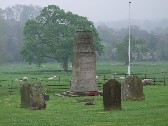 |
|
The 15th century wealth of
South Suffolk almost completely rebuilt
many of its churches, and in the triangle
of Clare, Lavenham
and Stoke
by Nayland
are some of the best examples of
Perpendicular architecture in England.
How strange then to find, right in the
middle of this area, a maverick, a church
quite unlike any other in the county. A
beautiful, ancient place that speaks of
more distant days than parvenu
Perpendicular can possibly do. Is
this the most beautiful setting of any
medieval church in East Anglia? Perhaps
only Dalham is more sensational. That St
Mary is unusual is immediately apparent,
for this is the only medieval stone spire
in all Suffolk. Medieval spires of any
kind are unusual in the county; the only
full-sized one is at neighbouring Hadleigh,
and there are reconstructed medieval ones
at Bramford
and Rattlesden.
The stone spires of Woolpit
and St
Mary le Tower, Ipswich,
may be grand; but they are, of course,
modern inventions.
|
Polstead
churchyard is also clearly ancient, set high and
back from the village pond and street. In the
churchyard are the remains of the so-called
Gospel Oak, attributed with an age of 1300 years,
and believed to have been planted by St Cedd, or
at least his missionaries. There's no evidence
for this, of course, or even for it being that
age; although oaks have to come from somewhere,
and there may have been an earlier one on the
spot. The most beautiful view is to the east,
where surprisingly large hills climb to Nayland.
Here stands Polstead's war memorial, one of the
largest church war memorials in England,
remembering the Polstead men who did not come
back.
This
is an interesting village. As well as the pond,
there is an ancient pub, and most famously a
murder, for here it was that William Corder slew
Maria Marten, and buried her in the red barn,
before pretending to elope with her. It makes
Polstead the only parish in East Anglia which has
had a Tom Waits song written about it. More than
10,000 people witnessed Corder's execution on the
market hill in Bury; the account of his trial,
bound in his skin, can be seen at the Moyses Hall
museum there.
St
Mary has an unusual nave roof. Back in the 1980s,
essentail repairs had to be carried out
economically. Aluminium was chosen, and is a
striking sight from a distance on a sunny day.
Beneath it, you can see that the Perpendicular
age did not completely avoid St Mary, but most
details are Decorated, a sign of an early 14th
century rebuilding, when faith was still shot
through with mystery, and the cold theological
rationalism of the 15th century had not yet built
tall clerestories to let in the light. You go
round to the south side to get in, and because of
this many people miss the roundels and fragments
of glass set in the windows of the north porch:
continental pieces depict Judas betraying Christ
with a kiss, the three Magi adoring the infant
Jesus, and a pretty St Dorothy, surely part of
the same set as the roundels at South
Elmham All Saints in the north of the
county. There is more old glass inside, but those
fragments, in the south side of the chancel, are
plainly local, of the Norwich School of the late
15th Century. One depicts a bishop who may be St
Leger, and another is a sheep, a fine companion
to those in the field to the east of the church.
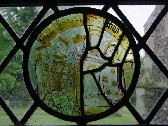 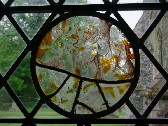 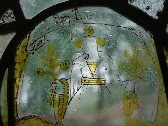 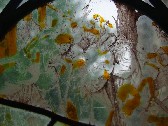
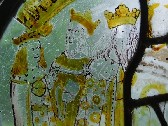 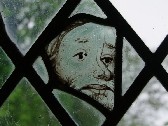 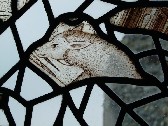 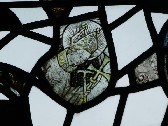
You
step inside to a beautiful space, touched with a
patina of age. The most striking aspect of the
interior is the colour, the combination between
white walls and the red brick of the arcade arches.
These bricks bear close examination. They date
from the original construction of the arcades,
about the year 1200, and yet they are clearly not
reused Roman bricks. So, we have here what may be
the oldest surviving English bricks still in use
for their original purpose - bricks of a similar
age can be found at the Hall at nearby Little Wenham, and
across the county border at Coggleshall Abbey in
Essex.
The
arcades predate the aisles, as we
have seen, and the little clerestory is hidden
by the aisle roofs. This is strange, and also
strange is that one of the arcades has been
replaced, that to the west end of the south
aisle, as though work began, but was not
completed. It doesn't take much imagination to
suggest that the Black Death of 1348-50 may have
finished off (quite literally) the work here. The
Norman arcades interlock and shift as we move
around the church, opening up new vistas and
elevations. There is much to see; an
extraordinary brick octagonal font, for instance,
which might be any age, but is set on a 13th
century base. Sam Mortlock was
uncharacteristically uncharitable about the
modern fibreglass cover, but I rather like it. On
the walls, two consecration
crosses sit surprisingly close together,
and another wall painting shows a figure, perhaps
a bishop. A brass in the north wall of the
chancel shows a priest dressed for the Mass - another
rare survival. Also in the chancel, a good set of
Laudian communion rails.
At
the west end of the nave there is a large opening
above the tower arch. This might be dismissed as
a sanctus
bell window, but I think it might be an
entrance to the tower itself, that a ladder could
be drawn up, as at Thorington. Step
through the arch, and turn east, and you see that
this, like Westhall, was
originally a Norman church with a west entrance;
the archway is clearly an exterior doorway, with
three bands of heavy chevrons. Above the chancel
arch there is a triple window that would have
provided a backlight to the rood. Just to
the south of the chancel arch, set at an angle,
is the memorial to Jacob and Benjamin Brand. The
Brands lived at Polstead Hall which you can still
see to the west of the church. It is said that
the little boy Benjamin was killed in a fall from
one of the upper storey windows.
| Before leaving Polstead,
don't miss the heartbreaking modern
memorial just to the east of the
churchyard gate. In Memoriam, it
is headed, and beneath it the inscription
is to Alexander James Sowman aged 32,
and his wife Jane aged 29, of this
village, both of whom died in 1907
leaving their children Ellen 10 years,
Annie 9 years, Alexander 6 years, Ivy 4
years, Rosa 4 months. At the bottom,
the inscription concludes Erected by
Anthea, the only Grand-daughter. This
is an outstandingly lovely church, full
of interest, and not simply because of
anything in particular that it contains,
but because of itself as a whole piece.
Just the way it should be.
|
|
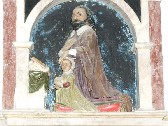 |
|
|
|

